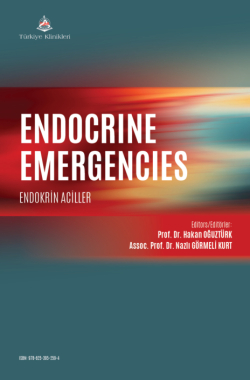Pituitary Insufficiency
Gökçe YOLCUa , İlksen OKURb
aAntalya City Hospital, Clinic of Emercency Medicine, Antalya, Türkiye
bOsmaniye State Hospital, Clinic of Emercency Medicine, Osmaniye, Türkiye
Yolcu G, Okur İ. Pituitary insufficiency. In: Oğuztürk H, Görmeli Kurt N, eds. Endocrine Emergencies. 1st ed. Ankara: Türkiye Klinikleri; 2024. p.63-6.
ABSTRACT
The pituitary serves as the central regulator of the endocrine system, affecting various organs and systems in the presence of hypopituitarism. While there is no significant difference in prevalence and incidence between male and female genders, advances in technology and imaging methods have increased the frequency of diagnosis in the overall population. Pituitary adenomas are the most common cause of hypopituitarism. Among other causes are surgery, radiation, trauma, infiltrative and genetic diseases, pituitaryitis, and infarction. Clinical presentation varies depending on the affected hormone. In cases of sudden periorbital headache, hypopituitarism should be considered. The most severe manifestation involves cortisol deficiency leading to vascular collapse, causing potentially fatal ACTH deficiency. Diagnostic tests are warranted based on clinical suspicion and confirmed radiographic imaging. Specific tests are available for evaluating deficiencies in respective hormones. Treatment involves replacement therapy for these deficiencies, and if a tumoral lesion is present, surgical resection is performed.
Keywords: Hypopituitarism; pituitary gland; adenohypophysis; hypopituitarism; pituitary diseases; pituitary hormones, anterior; pituitary gland, anterior
Kaynak Göster
Referanslar
- Higham CE, Johannsson G, Shalet SM. Hypopituitarism. Lancet. 2016; 388(10058):2403-2415. [Crossref] [PubMed]
- Nilsson B, Gustavasson-Kadaka E, Bengtsson BA, Jonsson B. Pituitary adenomas in Sweden between 1958 and 1991: incidence, survival, and mortality. J Clin Endocrinol Metab. 2000;85(4):1420-5. [Crossref] [PubMed]
- Raappana A, Koivukangas J, Ebeling T, Pirilä T. Incidence of pituitary adenomas in Northern Finland in 1992-2007. J Clin Endocrinol Metab. 2010; 95(9):4268-75. [Crossref] [PubMed]
- Olsson DS, Nilsson AG, Bryngelsson IL, Trimpou P, Johannsson G, Andersson E. Excess Mortality in Women and Young Adults With Nonfunctioning Pituitary Adenoma: A Swedish Nationwide Study. J Clin Endocrinol Metab. 2015;100(7):2651-8. [Crossref] [PubMed]
- Nomikos P, Ladar C, Fahlbusch R, Buchfelder M. Impact of primary surgery on pituitary function in patients with non-functioning pituitary adenomas -- a study on 721 patients. Acta Neurochir (Wien). 2004;146(1):27-35. Erratum in: Acta Neurochir (Wien). 2004;146(6): 433. [Crossref] [PubMed]
- Arafah BM, Prunty D, Ybarra J, Hlavin ML, Selman WR. The dominant role of increased intrasellar pressure in the pathogenesis of hypopituitarism, hyperprolactinemia, and headaches in patients with pituitary adenomas. J Clin Endocrinol Metab. 2000;85(5):1789-93. [Crossref] [PubMed]
- Arafah BM, Kailani SH, Nekl KE, Gold RS, Selman WR. Immediate recovery of pituitary function after transsphenoidal resection of pituitary macroadenomas. J Clin Endocrinol Metab. 1994;79(2):348-54. [Crossref] [PubMed]
- Gatto F, Grasso LF, Nazzari E, Cuny T, Anania P, Di Somma C, et al. Clinical outcome and evidence of high rate post-surgical anterior hypopituitarism in a cohort of TSH-secreting adenoma patients: Might somatostatin analogs have a role as first-line therapy? Pituitary. 2015;18(5):583-91. [Crossref] [PubMed]
- Snyder PJ, Fowble BF, Schatz NJ, Savino PJ, Gennarelli TA. Hypopituitarism following radiation therapy of pituitary adenomas. Am J Med. 1986;81(3):457-62. [Crossref] [PubMed]
- Ryder CY, Bellile EL, VanKoevering KK, McKean EL. Assessing Quality of Life among Radiation-Induced Hypopituitary Patients. J Neurol Surg B Skull Base. 2022;84(6):567-77. [Crossref] [PubMed] [PMC]
- Tanriverdi F, Schneider HJ, Aimaretti G, Masel BE, Casanueva FF, Kelestimur F. Pituitary dysfunction after traumatic brain injury: a clinical and pathophysiological approach. Endocr Rev. 2015;36(3):305-42. [Crossref] [PubMed]
- Fernandez-Rodriguez E, Bernabeu I, Castro AI, Kelestimur F, Casanueva FF. Hypopituitarism following traumatic brain injury: determining factors for diagnosis. Front Endocrinol (Lausanne). 2011;2:25. [Crossref] [PubMed] [PMC]
- Kaltsas GA, Powles TB, Evanson J, Plowman PN, Drinkwater JE, Jenkins PJ, et al. Hypothalamo-pituitary abnormalities in adult patients with langerhans cell histiocytosis: clinical, endocrinological, and radiological features and response to treatment. J Clin Endocrinol Metab. 2000;85(4):1370-6. [Crossref] [PubMed]
- Karaca Z, Tanriverdi F, Unluhizarci K, Kelestimur F. Pregnancy and pituitary disorders. Eur J Endocrinol. 2010;162(3):453-75. Erratum in: Eur J Endocrinol. 2010;162(6):1167. [Crossref] [PubMed]
- Albarel F, Gaudy C, Castinetti F, Carré T, Morange I, Conte-Devolx B, et al. Long-term follow-up of ipilimumab-induced hypophysitis, a common adverse event of the anti-CTLA-4 antibody in melanoma. Eur J Endocrinol. 2015;172(2):195-204. [Crossref] [PubMed]
- Keleştimur F. Sheehan's syndrome. Pituitary. 2003;6(4):181-8. [Crossref] [PubMed]
- Rajasekaran S, Vanderpump M, Baldeweg S, Drake W, Reddy N, Lanyon M, et al. UK guidelines for the management of pituitary apoplexy. Clin Endocrinol (Oxf). 2011;74(1):9-20. [Crossref] [PubMed]
- Capatina C, Inder W, Karavitaki N, Wass JA. Management of endocrine disease: pituitary tumour apoplexy. Eur J Endocrinol. 2015;172(5):R179-90. [Crossref] [PubMed]
- Antonopoulou M, Sharma R, Farag A, Banerji MA, Karam JG. Hypopituitarism in the elderly. Maturitas. 2012;72(4):277-85. [Crossref] [PubMed]
- Feldt-Rasmussen U, Effraimidis G, Klose M. The hypothalamus-pituitary-thyroid (HPT)-axis and its role in physiology and pathophysiology of other hypothalamus-pituitary functions. Mol Cell Endocrinol. 2021;525:111173. [Crossref] [PubMed]
- Hartman ML, Crowe BJ, Biller BM, Ho KK, Clemmons DR, Chipman JJ; HyposCCS Advisory Board; U.S. HypoCCS Study Group. Which patients do not require a GH stimulation test for the diagnosis of adult GH deficiency? J Clin Endocrinol Metab. 2002;87(2):477-85. [Crossref] [PubMed]
- Aimaretti G, Corneli G, Razzore P, Bellone S, Baffoni C, Arvat E, et al. Comparison between insulin-induced hypoglycemia and growth hormone (GH)-releasing hormone + arginine as provocative tests for the diagnosis of GH deficiency in adults. J Clin Endocrinol Metab. 1998;83(5):1615-8. [Crossref]

